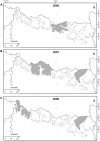Dynamics of an infectious keratoconjunctivitis outbreak by Mycoplasma conjunctivae on Pyrenean Chamois Rupicapra p. pyrenaica
- PMID: 23637923
- PMCID: PMC3634822
- DOI: 10.1371/journal.pone.0061887
Dynamics of an infectious keratoconjunctivitis outbreak by Mycoplasma conjunctivae on Pyrenean Chamois Rupicapra p. pyrenaica
Abstract
Between 2006 and 2008, an outbreak of Infectious Keratoconjunctivitis (IKC) affected Pyrenean chamois Rupicapra p. pyrenaica, an endemic subspecies of mountain ungulate that lives in the Pyrenees. The study focused on 14 mountain massifs (180,000 ha) where the species' population is stable. Cases of IKC were detected in ten of the massifs and, in five of them, mortality was substantial. The outbreak spread quickly from the first location detected, with two peaks in mortality that affected one (2007) and three (2008) massifs. In the latter, the peak was seasonal (spring to autumn) and, in the former, the outbreak persisted through winter. To identify the outbreak's aetiology, we examined 105 Pyrenean chamois clinically affected with IKC. TaqMan rt-PCR identified Mycoplasma conjunctivae in 93 (88.5%) of the chamois. Another rt-PCR detected Chlamydophila spp. in 14 of chamois, and 12 of those had mixed infections with mycoplasmas. In the period 2000-2007, the chamois population increased slightly (λ 1.026) but decreased significantly during the IKC outbreak (λ 0.8, 2007-2008; λ 0.85, 2008-2009) before increasing significantly after the outbreak (λ 1.1, 2009-2010). Sex-biased mortality shifted the adult sex ratio toward males (from 0.6 to 0.7 males per female) and reduced productivity slightly. Hunting was practically banned in the massifs where chamois experienced significant mortality and allowed again after the outbreak ended. Long-term monitoring of wild populations provides a basis for understanding the impacts of disease outbreaks and improves management decisions, particularly when species are subject to extractive exploitation.
Conflict of interest statement
Figures








Similar articles
-
Occurrence, quantification, and genotyping of Mycoplasma conjunctivae in wild Caprinae with and without infectious keratoconjunctivitis.J Wildl Dis. 2012 Jul;48(3):619-31. doi: 10.7589/0090-3558-48.3.619. J Wildl Dis. 2012. PMID: 22740528
-
Long-term dynamics of Mycoplasma conjunctivae at the wildlife-livestock interface in the Pyrenees.PLoS One. 2017 Oct 9;12(10):e0186069. doi: 10.1371/journal.pone.0186069. eCollection 2017. PLoS One. 2017. PMID: 29016676 Free PMC article.
-
Infectious keratoconjunctivitis in wild Caprinae: merging field observations and molecular analyses sheds light on factors shaping outbreak dynamics.BMC Vet Res. 2017 Mar 4;13(1):67. doi: 10.1186/s12917-017-0972-0. BMC Vet Res. 2017. PMID: 28259139 Free PMC article.
-
Infectious keratoconjunctivitis of ibex, chamois and other Caprinae.Rev Sci Tech. 2002 Aug;21(2):335-45. doi: 10.20506/rst.21.2.1338. Rev Sci Tech. 2002. PMID: 11974619 Review.
-
The two sides of border disease in Pyrenean chamois (Rupicapra pyrenaica): silent persistence and population collapse.Anim Health Res Rev. 2015 Jun;16(1):70-7. doi: 10.1017/S1466252315000055. Anim Health Res Rev. 2015. PMID: 26050575 Review.
Cited by
-
Diseases of Iberian ibex (Capra pyrenaica).Eur J Wildl Res. 2023;69(3):63. doi: 10.1007/s10344-023-01684-0. Epub 2023 Jun 1. Eur J Wildl Res. 2023. PMID: 37274486 Free PMC article. Review.
-
Infectious keratoconjunctivitis and occurrence of Mycoplasma conjunctivae and Chlamydiaceae in small domestic ruminants from Central Karakoram, Pakistan.Vet Rec. 2017 Sep 2;181(9):237. doi: 10.1136/vr.103948. Epub 2017 Aug 1. Vet Rec. 2017. PMID: 28765500 Free PMC article.
-
Mycoplasma infection and ocular surface diseases: a nationwide cohort study.Sci Rep. 2021 Nov 22;11(1):22680. doi: 10.1038/s41598-021-01941-9. Sci Rep. 2021. PMID: 34811377 Free PMC article.
-
Mycoplasma conjunctivae in domestic small ruminants from high mountain habitats in Northern Spain.BMC Vet Res. 2013 Dec 13;9:253. doi: 10.1186/1746-6148-9-253. BMC Vet Res. 2013. PMID: 24330682 Free PMC article.
-
Border Disease Virus: An Exceptional Driver of Chamois Populations Among Other Threats.Front Microbiol. 2015 Dec 18;6:1307. doi: 10.3389/fmicb.2015.01307. eCollection 2015. Front Microbiol. 2015. PMID: 26733943 Free PMC article.
References
-
- Hosie BD (2000) Ocular diseases. In: Martin WB, Aitken ID editors. Diseases of Sheep, 3rd Edition, Blackwell Science Ltd. 301–305.
-
- Giacometti M, Janovsky M, Jenny H, Nicolet J, Belloy L, et al. (2002) Mycoplasma conjunctivae infection is not maintained in Alpine chamois in eastern Switzerland. J Wildl Dis 38: 297–304. - PubMed
-
- Egwu GO, Faull WB, Bradbury JM, Clarkson MJ (1989) Ovine infectious keratoconjunctivitis: A microbiological study of clinically unaffected and affected sheep’s eyes with special reference to Mycoplasma conjunctivae . Vet Rec 125: 253–256. - PubMed
-
- Grattarola C, Frey J, Abdo EM, Orusa R, Nicolet J, et al. (1999) Mycoplasma conjunctivae infections in chamois and ibexes affected with infectious keratoconjunctivitis in the Italian Alps. Vet Rec 145: 588–589. - PubMed
-
- Giacometti M, Janovsky L, Belloy L, Frey J (2002) Infectious keratoconjunctivitis of ibex, chamois and other Caprinae. Rev Sci Tech Off Int Epiz 21: 335–345. - PubMed
Publication types
MeSH terms
LinkOut - more resources
Full Text Sources
Other Literature Sources
Miscellaneous

